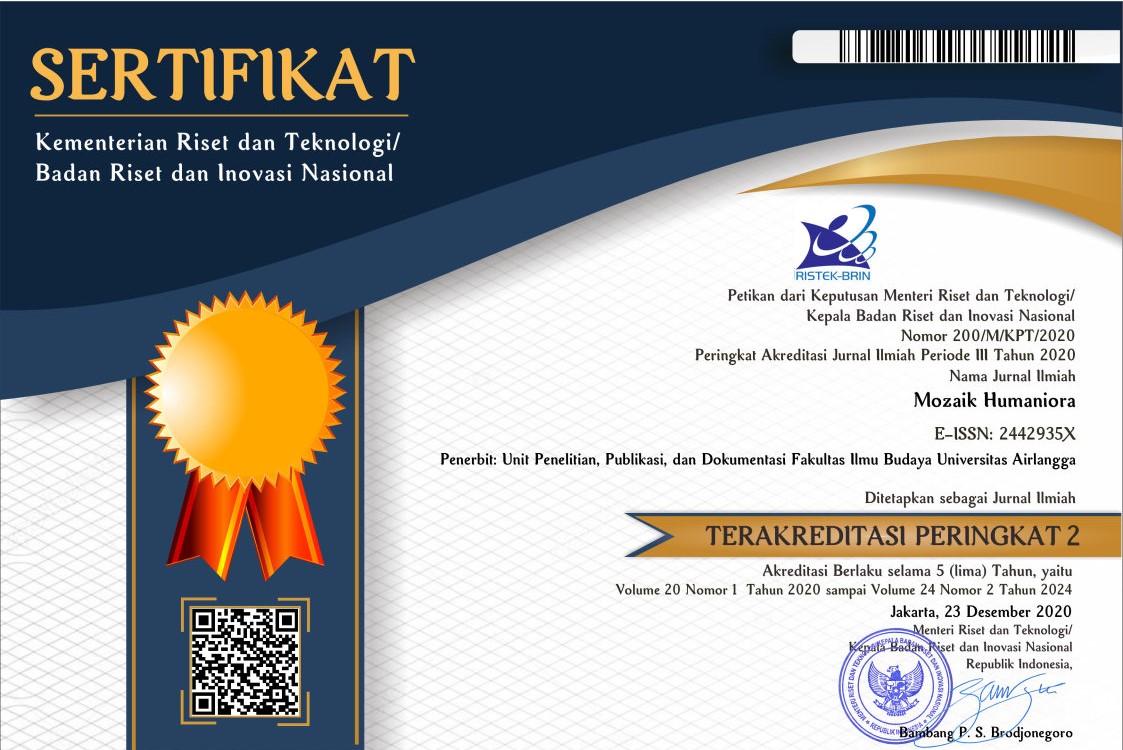Virtual Relationship in Moba-Based Game: Hyperreality of Intimacy Behind Anonymity in Mobile Legends Players
Downloads
The existence of games nowadays is not only for entertaining but also becomes virtual communication space. One of those games named Mobile Legends. This type of game is MOBA (Multiplayer Online Battle Arena) where communication among players determines victory. So that, its virtual communication can lead to a new cyberspace dynamic, namely virtual relationships formed through MOBA-based games. It makes this game look-a-like a dating application. However, Mobile Legends player accounts are anonymous, making it not exactly the same as a dating application in terms of initiating relationships in cyberspace. Therefore, this study aims to find out what features lead to virtual dating in Mobile Legends. This research is an ethnographic research with Jean Baudrillard’s Hyperreality approach and some ideas about intimacy relations. Based on the research findings, there is a couple affinity feature characterized by a rose symbol on players who are paired in Mobile Legends. This affinity has the opportunity to encourage players to carry out dating activities in the game because this affinity level will go up based on the intensity they play together. In addition, it is likely that Mobile Legends players do not solely interpret account anonymity as arbitrary. Player’s self-image representation mediated through profile features and their gameplays constructed as identities that attracts emotional passion between players. These features and meanings then make Mobile Legends’ players who are in a relationship feel intimacy that exceeds real world’s intimacy.
Barber, B. R. 1996. Jihad vs. McWorld: How Globalism and Tribalism are Reshaping the World. New York: Ballantine Books.
Baudrillard, J. 1983. Simulations. New York: Semiotext(e).
Baudrillard, J. 1993. Baudrillard Live: Selected Interviews. Edited by Mike Gane. London: Routledge.
Bell, D. 2001. An Introduction to Cybercultures. London: Routledge.
Duniagames.co.id. 2024. “Panduan Lengkap Affinity Mobile Legends.” Dunia Games, January 10. https://duniagames.co.id/discover/article/affinity-mobile-legends
Foucault, M. 1977. Discipline and Punish. New York: Vintage Books.
Freeman, G. B. 2016. “Revisiting Computer-Mediated Intimacy: In-Game Marriage and Dyadic Gameplay in Audition.” CHI Conference on Human Factors in Computing Systems (pp. 4325-4336). San Jose, CA: ACM Digital Library.
Griffin, E. 2006. A first look at communication theory (6th ed.). New York: McGraw-Hill.
Hidayat, M. A. 2021. Jean Baudrillard dan Realitas Budaya Pascamodern. Yogyakarta: Cantrik Pustaka.
Hunsinger, J, and TM Senft. 2014. The Social Media Handbook. New York: Routledge.
Kevino, S. 2018. “Apa itu MOBA” Esportnesia,Mei 17. https://esportsnesia.com/penting/apa-itu-moba/.
Kjeldskov, Jesper. dkk. (2004). Using Cultural Probes to Explore Mediated Intimacy. Australasian Journal of Information Systems. Vol. 11. No. 2., 102-115.
Kushendrawati, S. M. 2011. Hiperrealitas dan Ruang Publik: Sebuah Analisis Cultural Studies. Jakarta: Penaku.
Moleong, L. J. 2001. Metodelogi Penelitian Kualitatif (Edisi Revisi). Bandung: PT. Remaja Rosdakarya.
Nugroho, F., & Hasfi, N. 2019. Strategi Pengelolaan Kesan dalam Komunikasi Hyperpersonal Pengguna Tinder. From Interaksi Online, 7(4), 54-68: https://ejournal3.undip.ac.id/index.php/interaksi-online/article/view/24447
Nugroho, H., dkk. 2019. “Membongkar Delusi Subyek-Subyek Algoritmik Dalam Masyarakat Digital: Prospek Emansipasi, Keadilan, dan Inklusi Sosial dalam Ruang Percepatan.” Makalah Fakultas Ilmu Sosial dan Ilmu Politik UGM.
Pramesty, B. 2021. “Diskriminasi pada Pemain Game Online Perempuan (Woman Game Online Player Discrimination).” Jurnal Audience Vol. 04 No. 02, 234-248.
Rheingold, H. 1992. Virtual Reality. London: Mandarin Paperback.
Taylor, E. 2007. Dating Simulation Game: Leisure and Gaming of Japanese Youth Culture. Southeast Review of Asian Studies, 29, (pp. 192-208).
Uji, C. 2023. “Konsisten, Rata-Rata Jumlah Pemain Mobile Legends Stabil di Angka 80 Jutaan di 2022.” Hitekno, Februari 1. https://www.hitekno.com/games/2023/02/01/090327/konsisten-rata-rata-jumlah-pemain-mobile-legends-stabil-di-angka-80-jutaan-di-2022
Walther, J. 1996. “Computer-mediated communication: Impersonal, interpersonal, and hyperpersonal interaction.” Communication Research 23(1), 3-43.
Wang, C., and Y Chang. 2010. “Cyber Relationship Motives: Scale Development and Validation.” Social Behavior & Personality: An International Journal, 38(3), 289-300.
Wood, A, and MJ Smith. 2005. Online Communication Linking Technology, Identity, and Culture. Second edition. New Jersey: Lawrence Erlbaum Associates.
Copyright (c) 2024 Wahdah Kamelia Salsabila -

This work is licensed under a Creative Commons Attribution-ShareAlike 4.0 International License.

Mozaik Humaniora is licensed under a Creative Commons Attribution-ShareAlike 4.0 International License. Both authors and Mozaik Humaniora agree with the following attribution of journal:
1. Copyright of this journal is possession of Author, by the knowledge of the Editorial Board and Journal Manager, while the moral right of the publication belongs to the author.
2. The journal allows the author(s) to retain publishing rights without restrictions
3. The legal formal aspect of journal publication accessibility refers to Creative Commons Attribution Share-Alike (CC BY-SA).
4. The Creative Commons Attribution Share-Alike (CC BY-SA) license allows re-distribution and re-use of a licensed work on the conditions that the creator is appropriately credited and that any derivative work is made available under "the same, similar or a compatible license”. Other than the conditions mentioned above, the editorial board is not responsible for copyright violation.


















